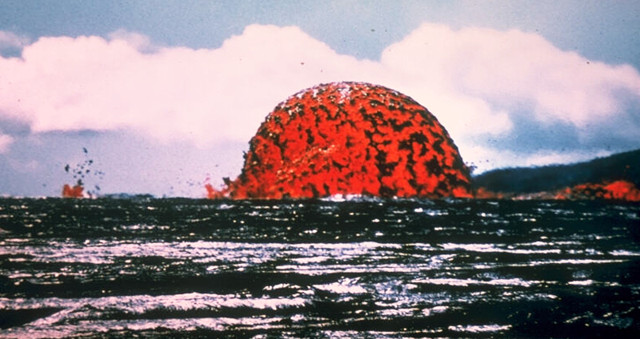
by Wendell A. Duffield Friday, August 19, 2016

The dome fountain shown here is about 20 meters (66 ft) tall and formed during the 1969-71 Mauna Ulu eruption of Kilauea Volcano, Hawai`i. Credit: public domain.
The article “The Question of Mantle Plumes” in the January/February 2016 issue of EARTH was a well-researched and educational reminder that the mantle plume model is far from established as an accurate depiction of circulation in the mantle. It reminded me of my personal, evolving trip along the plate tectonic road.
My undergraduate geology education at Carleton College, from which I graduated in 1963, predated the wide acceptance of global plate tectonics, while my graduate years at Stanford overlapped with the early descriptions of that model in the peer-reviewed scientific literature.
In 1969, two years after receiving my doctorate, I joined the U.S. Geological Survey in Menlo Park, Calif., and was assigned to a three-year tour at the survey’s Hawaiian Volcano Observatory (HVO). Thus, I found myself in a position to help educate undergraduate students and postgraduate researchers alike about the geometry of global-scale plate motions, which were hard to explain and visualize in a typical classroom setting. My alternative classroom for this was Kilauea Volcano.
Geology was abuzz with plate tectonics during those HVO years, and quite serendipitously I was witness to a miniature version that played out in the thinly crusted-over surface of a lake of molten basalt in the crater of Mauna Ulu, an active parasitic shield volcano that grew on the east rift zone of Kilauea.
The crust of the Mauna Ulu lava lake was an analogue for the lithosphere, while the restless, underlying melt was the asthenosphere. (Today, Earth’s lithosphere includes both the continents and the extensive basaltic ocean floors, whereas the lava-lake version includes only a basaltic crust. I imagine that the lava-lake version mimics the conditions of an early basalt-crusted Earth, before the formation of the rocks that eventually evolved into continents.)
At Mauna Ulu, I filmed the plate-tectonic motions of the thin crust and captured still photos. I also measured rates of crustal movement and estimated the thickness of the crust. Copies of the movie and slides were distributed worldwide to professors who were delighted to have a teaching aid that illustrated the plate-tectonic motions of Earth’s crust at a scale that was much easier for students to grasp. Geotimes (the former incarnation of EARTH) ran a piece on this in the April 1972 issue. I also published “A Naturally Occurring Model of Global Plate Tectonics” in the May 10, 1972, issue of the Journal of Geophysical Research.
For years, I, like many in the geoscience community, as noted in the EARTH article, blindly accepted the notion of mantle plumes as described by Jason Morgan. But, over time, I’ve come to question that model for the Hawaiian-Emperor volcano chain, and for other purported plumes. One of the experiments I was never able to perform at the Mauna Ulu lava lake was to determine, at least in part, the pattern of flow of the basalt melt beneath the thin crustal plates. Were the plates carried along by somewhat faster lateral flow of the melt pulling them along, or were they being tugged by gravity, slipping and sliding downslope, albeit a gentle slope, faster than the melt was moving? Or, perhaps both processes were at work at different places on the lava lake?
As to the fundamental issue of whether plumes occur or not, I think Warren Hamilton’s observation in the EARTH story, that “it’s no coincidence that the famous dog-leg bend in the Hawaiian-Emperor chain … crosses the Mendocino Transform Fault,” is very pertinent. It seems logical that this scar-like feature — along which crusts differing in age by about 30 million years are “stitched or healed” together — might reorient the direction of a crustal tear easily in response to divergent pulls (or pushes) on plates subducting along the Aleutians and along the western Pacific. In general, the seafloor crust is so thin relative to the size of its planetary host (picture it as a sheet of writing paper covering a volleyball) that I can imagine seafloor basalt tearing, breaking or rupturing rather easily, without the aid of a mantle plume blowtorch providing the necessary “oomph.” And once a tear is initiated, it might propagate, allowing depressurized asthenospheric melt to erupt in step. Food for thought. And it’s another example of how the scientific enterprise advances through the continuing input of data and new interpretations of those data.
© 2008-2021. All rights reserved. Any copying, redistribution or retransmission of any of the contents of this service without the expressed written permission of the American Geosciences Institute is expressly prohibited. Click here for all copyright requests.